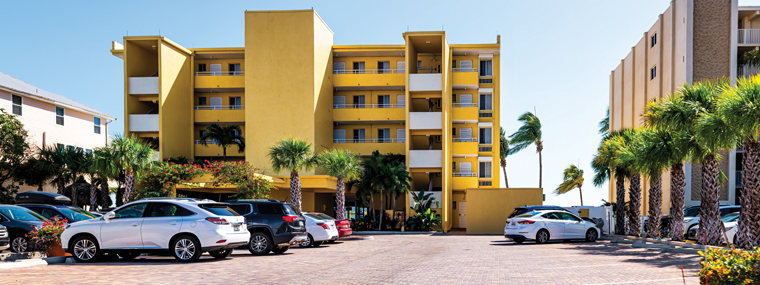
The Bane of Parking Areas
By Michael J. Gelfand, Esq. / Published December 2020

R
eally? Ice Cream Cone Distration Causes Liability? Community Parking Lot Conundrums!
Parking areas are the bane of many Florida community associations. Whether designed as a parking lot, designated as a parking space, or just a place for a car, Florida condominium and homeowners associations seem to regularly face claims regarding these common elements/areas.
No, claims are not just from crashes and run overs. Claims arise from slips, trips, and falls.
So, what happens when someone crossing a parking area looks up and invariably slips, trips, or falls over a hole in a parking lot? Will there be a valid claim? Even if the hole was open and obvious?
Generally, readers know of the general rule that associations owning or controlling property owe a duty to warn of dangerous conditions. But what if the danger is open and obvious? The answer may depend on whether the hole was actually seen.
Recently, a Florida appellate court ruled that even where a hole in a parking lot was “open and obvious,” the landowner was not excused from its duty to warn of the danger. In Greene v. Twistee Treat USA, 45 Fla. L. Weekly D 2101 (Fla. 2nd DCA, September 4, 2020), the facts indicate that an invitee was walking with her two young children to an ice cream shop located in a parking lot. She tripped and fell after her foot got caught in a small hole which she allegedly did not see. She claimed to be distracted by the appearance of the building, which was shaped like a giant ice cream cone!
The invitee sued the owner of the shopping center for negligence. The trial court found that the depression in the parking lot was open and obvious and granted a summary judgment for the owner of the shopping center, finding no liability.
The Florida appellate court reversed the decision of the trial court. The appellate court remarked that the general rule is that a property owner does not owe a duty to protect an invitee against dangers which are so obvious and open that the invitee should discover the danger.
Nonetheless, the court continued, holding that the rule is not fixed in stone. When a dangerous condition is open and obvious, the owner of the property is not excused from its duty to warn if there is reason to expect that the invitee’s attention will be distracted such that the invitee will not discover the condition.
In this case, the appellate court pointed out that the ice cream shop, which was a freestanding building, was shaped like a giant ice cream cone. The court, in sending the case back for a jury trial, found that a jury could conclude that the owner reasonably should have anticipated that an invitee walking in the parking lot to visit the ice cream shop would be distracted by its “striking appearance.”
This case is important to associations, particularly those that have architectural, design landscaping, or other eye-attracting features. Those features should not be so distracting that they lull passersby into staring at the feature, ignoring potential dangers in their path. Associations may still have a duty to warn of open and obvious dangers!
These situations can occur in many contexts. Consider when a parent or grandparent is walking with young children, or when someone has lots of bags in their arms.
If a dangerous condition cannot be corrected swiftly, consider placing a warning, perhaps a cone, over the condition to provide notice of potential dangers.
Does it matter what phase it is? Communities responding as adults, not adolescents!
Floridians brace for a potential autumn resurgence of COVID-19. “Snowbirds” reevaluate whether it is safe to return to Florida.
In the midst of all this, directors and managers seem to be caught in a vortex trying to meet their duties, generally to the public and more specifically to owners and residents.
The current proliferation of executive orders has not been perceived as providing practical guidance by many Florida community associations. While most owners seek to be helpful by adding their proverbial “two cents,” these “armchair lawyers” who are second guessing association actions frequently add inaccuracies and confusion, sometimes riling up residents and owners and spawning unnecessary conflict and even litigation!
So how do we move forward? Florida associations’ focus has been correctly on the safety of residents. The approach of the end of the year adds an emphasis upon administration, specifically orderly meeting procedures for annual budget and assessment approvals, and elections.
How do communities address both safety and administration in the continuing, rapidly changing atmosphere? As the Governor’s Emergency Orders do not act like a magic wand resolving issues for Florida associations, these two issues are tackled below.
Safety
Safety duties concerning Florida condominium and cooperative associations are similar initially but swiftly diverge from the duties concerning most homeowners associations. The divergence rests primarily in the different physical and legal structures, in part arising from the fundamental difference between jointly owned condominium common elements and homeowner’s association-owned common areas.
In condominiums and cooperatives owners and residents rely on common elements/areas not just for access, but also for physical support of their units and for the supply of utilities and services. In many homeowners associations common areas relied upon for habitation are limited to roadways and sometimes water management areas. This fundamental difference explains in large part the Florida Legislature’s different approaches.
Of perhaps greatest importance is the so called “non-delegable duty” that condominium associations owe to maintain common elements. This duty was examined in the firm’s August 2020 Memorandum to Clients which reviewed the Vogel v. Cornerstone Doctors Condominium Association, Inc., 45 Fla. L. Weekly D 1630 (Fla. 2nd DCA, July 8, 2020), decision.
This decision means that condominium associations cannot just merely rely on someone else to fulfill the duty to maintain common elements. This further means that a condominium association must, at a minimum, take reasonable steps to assure that common elements are safe for their proper use. A corollary duty and likely a requirement is to warn when there is a danger. Cooperative associations with similar statutory duties are likely to be held to a similar status as condominium associations.
Homeowners associations do not have a similar statutory duty. Nevertheless, many homeowners associations’ “governing documents” contain duties created by a community’s developer generally requiring the homeowners association to properly maintain common areas. Some homeowners association documents go further, expressly requiring protection of the safety of owners and residents.
What is the practical impact? Associations of all types must take reasonable steps to protect those utilizing common elements and common areas from anticipated dangers. As a reminder, though not undertaken by many associations, a fundamental first step is enacting “emergency” procedures as allowed by the Legislature and amending those procedures as additional information becomes available.
On the ground in Florida, the new “normal” means rules for mandatory mask wearing, six-foot physical distancing between groups, groups being limited to ten persons, facility capacity limits, and wiping and cleaning contact surfaces.
While the emphasis is on safety, there is the corollary of reducing risks of legal liability. Warning signage is a good first step. Other risk avoidance techniques that work in other circumstances may not be practical but still can be considered.
For example, a mandatory advance liability release form can be signed before accessing a facility. However, the existence of the non-delegable duty discussed above for condominium and cooperative associations has led to questioning the efficacy of a release in those communities. In homeowners associations the duties created by the homeowners association’s documents will likely impact whether a release document is enforceable.
Next, what happens when an owner or a resident refuses to comply with a rule? If a manager’s careful suggestions and overtures to the community’s well-being are not successful, then most associations have coercive enforcement mechanisms, even if they do not want them to be used. These include the following:
- Fining authority.
- Authority to suspend an owner’s use of certain common elements/common areas, especially recreational facilities.
- Locking down a facility, which has been found effective for a short term when an owner repeatedly refuses to obey basic safety guidelines and endangers others. This can send a message to the entire community regarding the seriousness of the situation.
- Though no one desires the expenditure of time and money, there are the alternatives of mediation and arbitration.
- Finally, there is the classic remedy of litigation.
Each community can customize enforcement to its needs.
Administration
Florida community associations have been able to have electronic meetings, both by telephone and other electronic means, for quite some time. The use of video meeting technology has been enormously successful—so much so that many associations are adopting video meetings permanently.
Associations still need to hold meetings to adopt annual budgets and their corresponding assessments. Notices of meetings also are normally required, including the special statutory language and documentation for these meetings.
Owners still can vote during electronic meetings. Limited proxies still can be utilized for most business. In condominium and cooperative associations director election absentee ballots can still be mailed. Mail-in absentee ballots have been successfully counted with transparency, utilizing video broadcasting of the count from the location of the meeting.
Other tools that associations frequently forget include the adoption of rules regulating the conduct of meetings. These rules have been especially effective in channeling members’ comments in a reasonable and orderly fashion, particularly setting ground rules in advance of the meeting.
Wrap Up
We try to avoid the all too familiar “Woe is me!” In the months since Florida’s state of emergency was declared, commentators repeatedly concentrated on the shortfalls of the statutory emergency power provisions, the Governor’s orders having lack of appropriate language, and the Department of Business Regulation’s relative silence.
Nevertheless, as the saying goes, “It is what it is!” We must move forward and govern. Thus, instead of concentrating on the failures of lawmakers and governmental officials, attorneys seek to provide straightforward direction allowing for actual governance.
An essential component is education of owners and residents. Particularly in this highly politicized environment many owners still do not understand the actual guidelines and impacts on the community. Sometimes pointing out losses of individuals within the community to community members reinforces the appropriateness of association action.
Again, each community’s governing documents must be reviewed with your association counsel. Above all, do not lose focus on common sense, including your members and residents to encourage their active participation in support of rational conduct.
Michael J. Gelfand, Esq.
Senior Partner, Gelfand & Arpe, P.A.
Michael J. Gelfand, Esq., the Senior Partner of Gelfand & Arpe, P.A., emphasizes a community association law practice, counseling associations and owners how to set legitimate goals and effectively achieve those goals. Gelfand is a dual Florida Bar Board Certified lawyer in Condominium and Planned Development Law and in Real Estate Law, Certified Circuit and County Civil Court Mediator, Homeowners Association Mediator, an Arbitrator, and Parliamentarian. He is a past Chair of the Real Property Division of the Florida Bar’s Real Property, Probate & Trust Law Section, and a Fellow of the American College of Real Estate Lawyers. Contact him at ga@gelfandarpe.com or (561) 655-6224.




